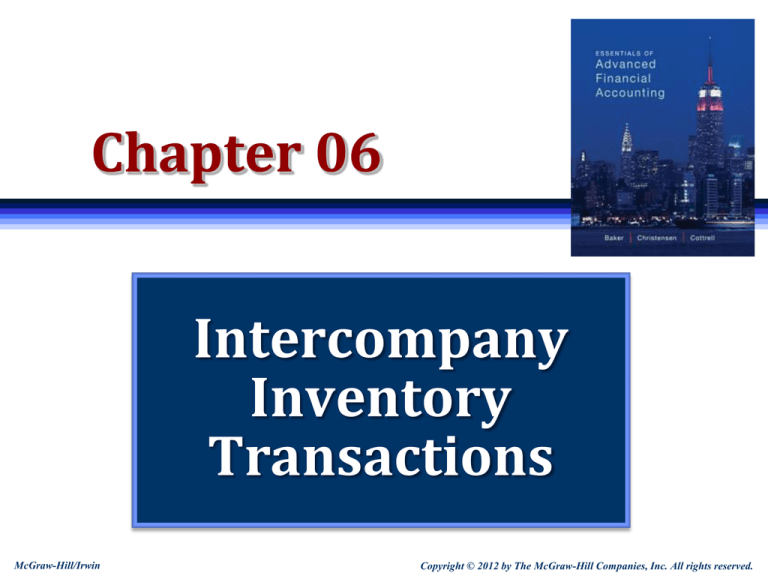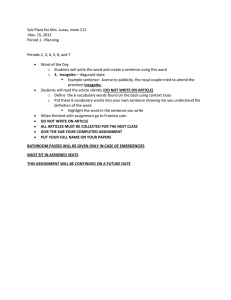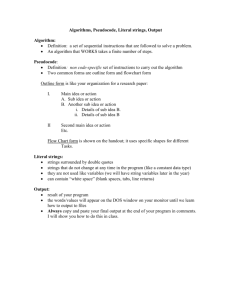
Chapter 06
Intercompany
Inventory
Transactions
McGraw-Hill/Irwin
Copyright © 2012 by The McGraw-Hill Companies, Inc. All rights reserved.
Learning Objective 1
Understand and explain
intercompany transfers and
why they must be
eliminated.
6-2
Road Map: Intercompany Transactions
Typical intercompany transactions
Intercompany reciprocal accounts (Chapter 4)
Inventory transfers (Chapter 6)
Fixed asset transfers (Chapter 7)
Intercompany Indebtedness (Chapter 8)
6-3
Arm’s-Length Transactions
Q:
What are “Arm’s-length” Transactions?
A:
“Transactions that take place between
completely independent parties.”
6-4
Categories of Transactions
Arm’s Length Transactions
The only transactions that can be reported in the
consolidated statements.
We want to report the results of our interactions
with outside parties!
Non-Arm’s Length Transactions
Usually referred to as “related party
transactions.”
Include all intercompany transactions.
6-5
Types of “Related Party” Transactions
Involving only Individuals
Transactions among family members
Involving Corporations
With management and other employees
With directors and stockholders
With affiliates (controlled entities)
Probably constitutes at least 99% of all corporate
related-party transactions
6-6
Necessity of Eliminating Intercompany Transactions
Eliminate all intercompany transactions in
consolidation:
Because they are internal transactions from a
consolidated perspective.
Not because they are related-party transactions.
Only transactions with outside unrelated parties
can be reported in the consolidated statements.
6-7
Let’s work through an example:
Assume Parent Co. owns 100% of Sub Co.
The following intercompany transactions occurred during
the year:
Parent loaned $500 to Sub. To keep things simple, assume that
there is no interest revenue or interest expense associated with this
loan.
Parent made a sale to Sub for $400 cash. The inventory had
originally cost Parent $250. Sub then sold that same inventory to an
outsider for $500.
Parent made a sale to Sub for $300 cash. The inventory had
originally cost Parent $200. Sub has not yet sold that same
inventory to an outsider.
What consolidation worksheet entries would you make?
6-8
(a) Loan from Parent to Sub
Does this transaction include outsiders?
Parent $500
Sub
Reverse the entries made by
the parent and the sub.
To eliminate intercompany loans:
Loan Payable
Loan Receivable
Parent:
Receivable
Cash
Sub:
Cash
500
500
500
Payable
500
500
500
6-9
(b) Sale from Parent to Sub to Outsider
Arm’s
Length
Keep Parent’s COGS
Keep Sub’s Sale
Are these legitimate transactions?
$250
Keep
This
Purchase
Parent $400
Eliminate effect
of this internal
Transaction
Get rid of Parent’s Sale
Sub
$500
Keep
This
Sale
Get rid of Sub’s COGS
Internal (fake)
6-10
(b) Sale from Parent to Sub to Outsider
Which transactions are legitimate?
Parent’s sale to Sub:
Sub’s sale to Outsider:
Parent:
Cash
Sales
COGS
Inventory
Sub:
Inventory
Cash
Sub:
Cash
500
Sales
500
COGS
400
Inventory
400
400
400
250
250
400
400
Reverse the rest!
To eliminate sale from Parent to Sub to Outsider:
Sales (parent to sub)
400
Cost of Goods Sold (to outsider)
400
6-11
(c) Sale From Parent to Sub (Not Outside)
Is this a legitimate arm’s length transaction?
$200
Keep
this
purchase
Parent $300
Sub
Eliminate effect
of this internal
transaction
Parent:
Cash
300
Sales
300
COGS
200
Inventory
200
Sub:
Inventory 300
Cash
300
Summary of the Transaction:
Parent purchased inventory for $200.
Parent sold the inventory to a Sub for $300.
Reverse the entries made by the parent and sub.
6-12
(c) Sale From Parent to Sub (Not Outside)
Reverse the entries made by the parent and sub.
Parent:
Cash
300
Sales
300
COGS
200
Inventory
200
Sub:
Inventory
Cash
Parent $300
Sub
300
300
To eliminate sale from Parent to Sub, not yet to Outsider:
Sales
300
Cost of Goods Sold
200
Inventory (net)
100
6-13
Summary of Consolidation Entries:
To eliminate intercompany loans:
Loan Payable
Loan Receivable
500
To eliminate sale from Parent to Sub to Outsider:
Sales
400
Cost of Goods Sold
500
400
To eliminate sale from Parent to Sub, not yet to Outsider:
Sales
300
Cost of Goods Sold
200
Inventory
100
6-14
Chapter 6
Prepare equity-method journal
entries and elimination entries
for the consolidation
of a subsidiary following
downstream inventory
transfers.
6-15
Agreement between Parent Company and
Consolidated Financial Statements
Under the fully adjusted equity method,
the parent company’s financial statements should
report the same net income and retained earnings
amounts as appear in the consolidated statements.
Therefore, we
record and equity method adjustment on the
parent’s books to defer unrealized gross profit,
and
prepare consolidation worksheet elimination
entries to avoid double counting in the income
statement and overstating inventory.
6-16
Big Picture—Elimination entry: Sale From Parent to
Sub to Outsider
To eliminate sale from Parent to Sub to Outsider:
Sales (Parent)
400
Cost of Goods Sold (Sub)
400
Get rid of the non-arm’s-length transaction!
$250
Parent
$400
Sub
$500
6-17
Big Picture—Elimination entry: Sale From Parent to
Sub (not yet sold outside)
Reverse the entire transaction!
To eliminate sale from Parent to Sub, not yet to Outsider:
Sales
400
Cost of Goods Sold
250
Inventory
150
Equity Method Entry:
Income from Sub
Investment in Sub
Sales
Cost of sales
Gross profit
$250
$400
250
$ 150
Parent
150
150
Parent’s gross profit is overstated by $150
Sub’s inventory is overstated by $150
$400
Sub
6-18
What to Look For
Most problems will contain
Inventory transferred from parent to sub (downstream),
or
Inventory transferred from sub to parent (upstream).
Often part of the inventory is sold to an
outsider, but part remains in the buyer’s
ending inventory.
Key: Any problem can be split into two parts
The portion of the inventory that is sold
The portion of the inventory that is still on hand
6-19
A Comprehensive Downstream Example
During 20X8, Parent sold inventory originally costing
$60,000 to its 100% owned Sub for $75,000. Sub sold most
of the inventory purchased from Parent (all but $10,000)
for $70,000 to outsiders during the year.
Income Statements
Parent
Sales
$75,000
Cost of sales
60,000
Gross profit $15,000
Sub
$70,000
65,000
$ 5,000
What happened to it?
Sold On-hand
$65,000 $10,000 x 20% = $2,000
Unrealized GP
Ending inventory = $10,000
$75,000
Split
60,000
Parent
75,000
Sub
70,000
6-20
One Approach: Split into Two Transactions
This transaction can be broken into two pieces:
Parent sells Sub inventory with a cost of $52,000 for
$65,000. Sub then sells this inventory to outsiders for
$70,000.
Parent sells Sub inventory with a cost of $8,000 for
$10,000, which remains on hand in Sub’s ending
inventory.
Total
Sold
On hand
Sales
$75,000
$65,000
$10,000
COGS
60,000
52,000
8,000
Gross Profit
$15,000
$13,000
$ 2,000
6-21
Part 1: Sale from Parent to Sub to Outsider
To eliminate sale from Parent to Sub to Outsider:
Sales (Parent)
65,000
Cost of Goods Sold (Sub)
65,000
Get rid of the non-arm’s-length transaction!
$52,000
Parent
$65,000
Sub
$70,000
6-22
Part 2: Sale from Parent to Sub (Not Outside)
Reverse the entire transaction!
To eliminate sale from Parent to Sub, not yet to Outsider:
Sales (Parent)
10,000
Cost of Goods Sold (Parent)
8,000
Inventory (basis correction)
2,000
Sales
Cost of sales
Gross profit
$8,000
$10,000
8,000
$ 2,000
Parent
Parent’s gross profit is overstated
by $2,000
Sub’s inventory is overstated by $2,000
$10,000
Sub
6-23
Summary
To eliminate sale from Parent to Sub to Outsider :
Sales (Parent)
65,000
Cost of Goods Sold (Sub)
65,000
To eliminate sale from Parent to Sub, not yet to Outsider:
Sales (Parent)
10,000
Cost of Goods Sold (Parent)
8,000
Inventory (basis correction)
2,000
Can combine the two entries:
Sales
Cost of Goods Sold
Inventory
75,000
73,000
2,000
6-24
Partial Consolidated Worksheet
Parent
Income Statement
Sales
75,000
COGS
Gross Profit
Balance Sheet
Inventory
60,000
15,000
0
Sub
DR
CR
70,000 75,000
65,000
5,000 75,000
10,000
Consolidated
70,000
73,000
73,000
52,000
18,000
2,000
8,000
6-25
Second Approach: Short Cut Method
Total
Sold
On hand
Sales
$75,000
$65,000
$10,000
COGS
60,000
52,000
8,000
Gross Profit
$15,000
$13,000
$ 2,000
COGS Credit = $65,000 + $8,000
The numbers come right off the chart!
Sales
Cost of Goods Sold
Inventory
75,000
73,000
2,000
6-26
Fully-adjusted Equity Method Adjustment
Don’t forget that one of the desirable properties
of using the equity method is that the parent’s
net income should be equal to the consolidated
net income.
If you only adjust for unrealized deferred profit
in the consolidation, the consolidated net income
will be different from the parent’s income!
6-27
Partial Consolidated Worksheet
Parent
Income Statement
Sales
75,000
COGS
Inc from Sub
Net Income
60,000
5,000
20,000
Sub
0
CR
70,000 75,000
65,000
10,000
70,000
73,000
52,000
73,000
18,000
Not the same!
2,000
8,000
5,000
5,000 80,000
Balance Sheet
Inventory
DR
Consolidated
6-28
Fully-adjusted Equity Method Adjustment
Don’t forget that one of the desirable properties
of using the equity method is that the parent’s
net income should be equal to the consolidated
net income.
If you only adjust for unrealized deferred profit
in the consolidation, the consolidated net income
will be different from the parent’s income!
Thus, an actual adjustment on the parent’s books
in addition to the worksheet entries above.
Like we did for the excess fair value amortization.
6-29
Fully-adjusted Equity Method Adjustment
After calculating the unrealized
deferred profit, simply make an extra
adjustment to back it out.
Do this at the same time you record
the parent’s share of the sub’s
income.
Investment in Sub
Parent NI =
Consolidated NI
Sales
$75,000
COGS
60,000
Gross profit
$15,000
Inc. from Sub
3,000
NI
$18,000
Income from Sub
NI 5,000
5,000 NI
2,000
Unreal GP
2,000
3,000
Reverse next year when this inventory is sold!
6-30
Partial Consolidated Worksheet
Parent
Income Statement
Sales
75,000
COGS
Inc from Sub
Net Income
60,000
3,000
18,000
Balance Sheet
Inventory
0
Sub
DR
CR
70,000 75,000
65,000
3,000
5,000 78,000
Consolidated
70,000
73,000
52,000
73,000
18,000
Now they’re the same!
10,000
2,000
8,000
6-31
Practice Quiz Question #5
Under the fully adjusted equity method,
what is one benefit of making an equity
method adjustment to defer unrealized
gross profit on inventory transfers?
a. Consolidated net income always
increases.
b. Parent company net income always
increases.
c. Parent company net income is not equal
to consolidated net income.
d. Parent company net income equals
consolidated net income.
6-32
Review Exercise Part 1: Downstream
Para sold inventory costing $100,000 to its
75%-owned subsidiary, Shute, for $125,000
in 20X8.
NCI
Shute resold most of this inventory for
25%
$230,000 in 20X8.
At 12/31/X8, Shute’s balance sheet showed
intercompany-acquired inventory on hand of
$20,000.
P
75%
S
Required:
Prepare the consolidation entry and/or entries required
at 12/31/X8 under the equity method.
Since this is a DOWNSTREAM transaction, we don’t
share the GP deferral with the NCI.
6-33
Review Exercise Part 1: Big Picture
Total
Sales
125,000
COGS
100,000
Gross Profit
25,000
Sold
On hand
20,000
Gross Profit %
Ending Inventory = 20,000
Resold = $105,000
$125,000
split
$100,000
Parent
$125,000
Sub
$230,000
6-34
Review Exercise 1: Sale from Parent to Sub to
Outsider
To eliminate sale from Parent to Sub to Outsider:
Sales (Parent)
105,000
Cost of Goods Sold (Sub)
105,000
Get rid of the internal non-arm’s-length transaction!
$84,000
Parent
$105,000
Sub
$230,000
6-35
Review Exercise 1: Sale from Parent to Sub (Not Yet
Outside)
Reverse the entire transaction!
To eliminate sale from Parent to Sub, not yet to Outsider:
Sales (Parent)
20,000
Cost of Goods Sold (Parent)
16,000
Inventory (basis correction)
4,000
Sales
Cost of sales
Gross profit
$16,000
$20,000
16,000
Parent’s gross profit is overstated by $4,000
$ 4,000
Sub’s inventory is overstated by $4,000
Parent
$20,000
Sub
6-36
Review Exercise 1: Summary
To eliminate sale from Parent to Sub to Outsider:
Sales (Parent)
105,000
Cost of Goods Sold (Sub)
105,000
To eliminate sale from Parent to Sub, not yet to Outsider:
Sales (Parent)
20,000
Cost of Goods Sold (Parent)
16,000
Inventory (basis correction)
4,000
Combine both entries:
Sales
Cost of Goods Sold
Inventory
125,000
121,000
4,000
Fully-adjusted Equity Method Entry on Parent’s books:
Income from Sub
4,000
Investment in Sub
4,000
6-37
Review Exercise Part 1: Short Cut
Total
Sold
On hand
Sales
125,000
105,000
20,000
COGS
100,000
84,000
16,000
Gross Profit
25,000
21,000
4,000
COGS Credit = 105,000 + 16,000 = 121,000
Worksheet Elimination Entry:
Sales
Cost of Goods Sold
Inventory
Unrealized GP
125,000
121,000
4,000
6-38
Review Exercise Part 1
Worksheet Elimination Entry in Year 1:
Sales
Cost of Goods Sold
Inventory
125,000
121,000
4,000
FYI, this year’s deferral is REVERSED next year to recognize
when sold!
Worksheet Elimination Entry in Year 2:
Investment in Sub
Cost of Goods Sold
4,000
4,000
INCREASES income!
6-39
Review Exercise 1: Equity Method Entry
Investment in Sub
Income from Sub
93,750 75% NI
75% NI 93,750
4,000
Low 4,000
Defer GP
4,000
89,750
Downstream, so don’t split
the deferral with the NCI.
6-40
Review Exercise 1: Partial Consolidated Worksheet
Parent
Sub
DR
CR
Consolidated
Income Statement
Sales
125,000
230,000
COGS
100,000
105,000
Inc from Sub
89,750
Gross Profit
114,750
230,000)
121,000
125,000
214,750
121,000
31,250 Basic
114,750
84,000)
89,750 Basic
NCI in NI
CI in NI
125,000
125,000
246,000
146,000)
(31,250)
121,000
114,750)
4,000
16,000)
Balance Sheet
Inventory
20,000
6-41
Review Exercise 1: Equity Method Reversal Next
Year
Equity Method Adjustment on Parent’s books in 20X7:
Income from Sub
4,000
Investment in Sub
4,000
Reversal of 20X7 Deferral on Parent’s books in 20X8:
Investment in Sub
4,000
Income from Sub
4,000
6-42
Learning Objective 4
Prepare equity-method journal
entries and elimination entries
for the consolidation
of a subsidiary following
upstream inventory transfers.
6-43
Partially Owned Upstream Sales
Must share deferral with the NCI shareholders.
Simply split up the adjustment for unrealized
gross profit proportionately.
Equity Method
Adjustments
Investment in Sub
Income from Sub
NI 4,500
NCI
10%
P
90%
4,500 NI
1,800 Defer GP
1,800
2,700
NCI in NA of Sub
Unreal GP
200
S
Worksheet
Entry Only
6-44
Review Exercise Part 2
In 20X7, Sensei, a 90%-owned subsidiary of Padawan,
sold inventory to Padawan for $600,000, which includes a
markup of 25% on Sensei’s cost.
NCI
Padawan resold most of this inventory in 20X7 for
$588,000.
10%
At 12/31/X7, Padawan reported $110,000 of this
inventory in its balance sheet. (This ending inventory was
resold in 20X8 by Padawan.)
In 20X8, Sensei sold Padawan inventory for $900,000 that
had a cost of $675,000, of which Padawan resold $700,000
by12/31/X8 for $840,000.
P
90%
S
Required:
Prepare the consolidation entry and/or entries required
at 12/31/X8 under the equity method.
Since this is an UPSTREAM transaction, we do share the
GP deferral with the NCI.
6-45
Review Exercise Part 2: The Big Picture—20X7
Total
Sold
On hand
Sales
600,000
490,000 110,000
COGS
480,000
392,000
88,000
Gross Profit
120,000
98,000
22,000
Gross Profit % = 120,000 ÷ 600,000 = 20%
$600,000 – C = 0.25C
C = $600,000/1.25
= $480,000
?
Sub
$600,000
Unrealized GP
Ending Inventory = $110,000
Parent
?
6-46
20X7 Upstream Sales: Elimination Entries—20X7 &
20X8
20X7 Worksheet Elimination Entry:
Sales
600,000
Cost of Goods Sold
578,000
Inventory
22,000
Deferred GP this year “reversed”
to recognize in the financial
statements next year when sold.
20X8 Worksheet Elimination Entry:
Investment in Sub
19,800
NCI in NA of Sub
2,200
Cost of Goods Sold
NCI
10%
22,000
P
90%
S
6-47
20X7 Upstream Sales: Equity Method Adjustments
— 20X7 & 20X8
20X7 Equity Method Adjustment on Parent’s books:
Income from Sub
19,800
Investment in Sub
19,800
Deferral of GP in 20X7
because not yet sold this year.
NCI
10%
20X8 Equity Method Reversal of 20X7 Deferral (on
Parent’s books):
Investment in Sub
19,800
Income from Sub
19,800
P
90%
S
6-48
20X7 Upstream Sales: 20X7 Equity Accounts
Investment in Sub
Income from Sub
108,000 90% NI
90% NI 108,000
19,800
Low 19,800
X7 Deferral
19,800
88,200
6-49
20X7 Upstream Sales: 20X7 Partial Worksheet
Parent
Sub
DR
CR
Consolidated
Income Statement
Sales
588,000
600,000
COGS
490,000
480,000
Inc from Sub
88,200
Gross Profit
186,200
588,000)
578,000
120,000
688,200
578,000
9,800 Basic
186,200
392,000)
88,200 Basic
NCI in NI
CI in NI
600,000
120,000
698,000
196,000)
(9,800)
578,000
186,200)
22,000
88,000)
Balance Sheet
Inventory
110,000
6-50
Review Exercise Part 2
In 20X7, Sensei, a 90%-owned subsidiary of Padawan,
sold inventory to Padawan for $600,000, which includes a
markup of 25% on Sensei’s cost.
NCI
Padawan resold most of this inventory in 20X7 for
$588,000.
10%
At 12/31/X7, Padawan reported $110,000 of this
inventory in its balance sheet. (This ending inventory was
resold in 20X8 by Padawan.)
In 20X8, Sensei sold Padawan inventory for $900,000 that
had a cost of $675,000, of which Padawan resold $700,000
by12/31/X8 for $840,000.
P
90%
S
Required:
Prepare the consolidation entry and/or entries required
at 12/31/X8 under the equity method.
Since this is an UPSTREAM transaction, we do share the
GP deferral with the NCI.
6-51
Review Exercise Part 2: The Big Picture—20X8
Total
Sold
On hand
Sales
900,000
700,000 200,000
COGS
675,000
525,000 150,000
Gross Profit
225,000
175,000
50,000
Gross Profit % = 225,000 ÷ 900,000 = 25%
Unrealized GP
Ending Inventory = $200,000
675,000
Sub
$900,000
Parent
?
6-52
Review Exercise 2: Summary
To eliminate sale from Sub to Parent to Outsider:
Sales (Sub)
700,000
Cost of Goods Sold (Parent)
700,000
To eliminate sale from Sub to Parent, not yet to Outsider:
Sales (Sub)
200,000
Cost of Goods Sold (Sub)
150,000
Inventory (basis correction)
50,000
Combine both entries:
Sales
Cost of Goods Sold
Inventory
900,000
850,000
50,000
Fully-adjusted Equity Method Entry on Parent’s books:
Income from Sub
45,000
Investment in Sub
45,000
6-53
Review Exercise 2: Short Cut
Total
Sold
On hand
Sales
900,000
700,000
200,000
COGS
675,000
525,000
150,000
Gross Profit
200,000
175,000
50,000
COGS CR = 700,000 + 150,000 = 850,000
The Elimination Entry:
Sales
Cost of Goods Sold
Inventory
900,000
850,000
50,000
6-54
20X8 Upstream Sales: 20X8 Equity Accounts
Investment in Sub
Income from Sub
19,800 Low
19,800
90% NI 202,500
X7 Reversal
45,000
X8 Deferral
45,000 Low
19,800
202,500 90% NI
45,000
177,300
6-55
20X7 & 20X8 Upstream Sales: 20X8 Partial
Worksheet
Parent
Sub
DR
CR
Consolidated
Income Statement
Sales
840,000
900,000
COGS
700,000
675,000
900,000
840,000)
850,000
503,000)
22,000
Income from Sub
Gross Profit
177,300
317,300
177,300 Basic
225,000
NCI in NI
CI in NI
1,077,300
872,000
19,700 Basic
317,300
225,000
1,097,000
337,000)
(19,700)
872,000
317,300
50,000
150,000)
Balance Sheet
Inventory
Investment in Sub
NCI in NA of Sub
200,000
Low by
45,000
19,800
2,200
Basic X
2,200
6-56
Learning Objective 5
Understand and explain
additional considerations
associated with consolidation.
6-57






